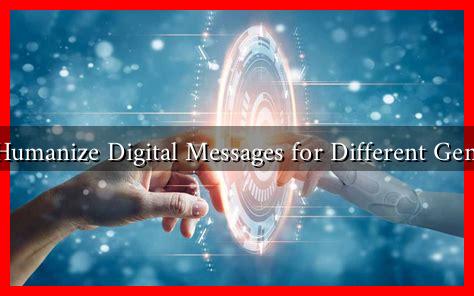-
Table of Contents
- How to Humanize Digital Messages for Different Generations
- Understanding the Generational Divide
- Strategies for Humanizing Digital Messages
- 1. Use Relatable Language
- 2. Leverage Visual Content
- 3. Personalize Communication
- 4. Foster Authenticity and Transparency
- Case Studies: Successful Humanization in Action
- Conclusion
How to Humanize Digital Messages for Different Generations
In an increasingly digital world, the way we communicate has evolved dramatically. With multiple generations interacting through various digital platforms, it is essential to tailor messages to resonate with each demographic. Humanizing digital messages not only fosters better connections but also enhances engagement and understanding. This article explores effective strategies for humanizing digital communication across different generations.
Understanding the Generational Divide
To effectively humanize messages, it is crucial to understand the characteristics and preferences of different generations. The primary generations in the workforce today include:
- Baby Boomers (1946-1964): Value personal interaction and loyalty.
- Generation X (1965-1980): Appreciate straightforward communication and work-life balance.
- Millennials (1981-1996): Seek authenticity and social responsibility.
- Generation Z (1997-2012): Favor visual content and quick, concise messages.
Each generation has unique preferences that influence how they perceive and respond to digital messages. Understanding these nuances is the first step in crafting effective communication.
Strategies for Humanizing Digital Messages
1. Use Relatable Language
Language plays a pivotal role in how messages are received. Tailoring your language to fit the audience can make a significant difference. For example:
- Baby Boomers: Use formal language and avoid slang. They appreciate respect and professionalism.
- Generation X: Be direct and concise. They value efficiency and clarity.
- Millennials: Incorporate storytelling and humor. They connect with relatable narratives.
- Generation Z: Use emojis and visual elements. They respond well to engaging and dynamic content.
2. Leverage Visual Content
Visual content is a powerful tool for engaging different generations. According to a study by HubSpot, 65% of people are visual learners. Here’s how to utilize visuals effectively:
- Infographics: Great for all generations, especially when conveying complex information.
- Videos: Short, engaging videos can capture the attention of Millennials and Gen Z.
- Images: Use relatable images that reflect the diversity of your audience.
3. Personalize Communication
Personalization is key to humanizing digital messages. Tailoring content to individual preferences can significantly enhance engagement. Consider the following:
- Email Marketing: Use the recipient’s name and segment your audience based on their interests.
- Social Media: Respond to comments and messages promptly to create a sense of community.
- Surveys and Feedback: Encourage feedback to understand preferences and improve future communications.
4. Foster Authenticity and Transparency
Authenticity is crucial, especially for Millennials and Gen Z, who value brands that are genuine and transparent. Here are some ways to convey authenticity:
- Share Stories: Use real-life stories and testimonials to build trust.
- Be Honest: Acknowledge mistakes and communicate openly about challenges.
- Showcase Values: Highlight your brand’s commitment to social responsibility and ethical practices.
Case Studies: Successful Humanization in Action
Several brands have successfully humanized their digital messages, leading to increased engagement and loyalty:
- Airbnb: Utilizes user-generated content to showcase real experiences, making their messaging relatable and authentic.
- Starbucks: Engages customers through personalized offers and community involvement, appealing to a broad audience.
- Netflix: Uses data-driven insights to recommend content, creating a personalized viewing experience for users.
Conclusion
Humanizing digital messages is essential for effective communication across generations. By understanding the unique preferences of each demographic, utilizing relatable language, leveraging visual content, personalizing communication, and fostering authenticity, brands can create meaningful connections with their audience. As the digital landscape continues to evolve, adapting communication strategies will be crucial for maintaining engagement and building lasting relationships.
For further insights on effective communication strategies, consider exploring resources from HubSpot and Forbes.

